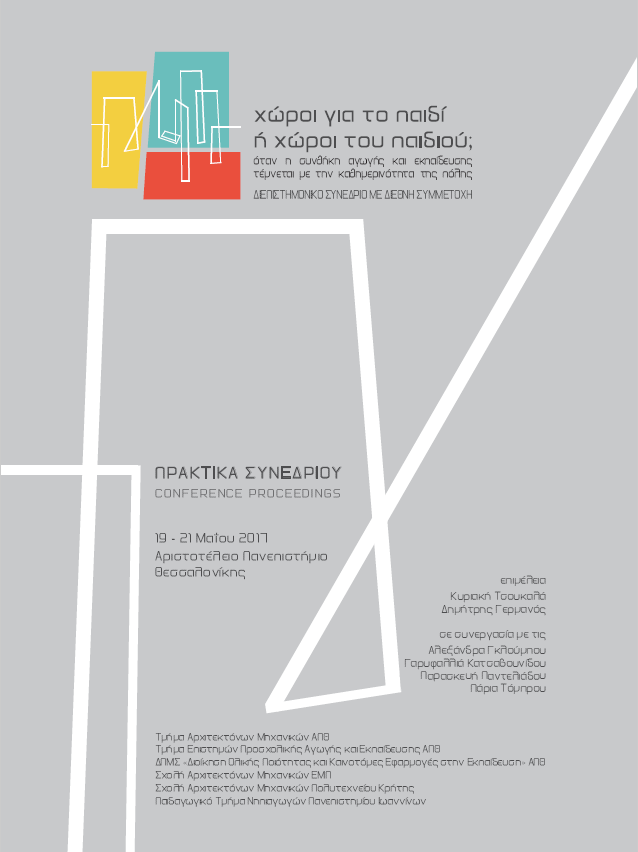Αμφίδρομα μαθήματα ή μαθήματα αναλογίας: Από το σχολείο στην πόλη και από την πόλη στο σχολείο

Περίληψη
Στην ομιλία μας, παρουσιάσαμε διαφορετικές παιδαγωγικές προσεγγίσεις, τις οποίες ονομάζουμε «παιδαγωγικές κλίμακες», επειδή θεωρούμε ότι μπορούν να συνεισφέρουν σε μια εγγύτερη ή μακρύτερη προοπτική του αστικού φαινομένου και συνολικά σε μία κλιμάκωση της εμπειρίας του παιδιού από τα μικρά στα μεγάλα πράγματα.
Πιο συγκεκριμένα συνδέουμε:
Α) την ενταξιακή εκπαίδευση με την πόλη ως χώρο συνύπαρξης διαφορετικοτήτων.
Β) τη διάδραση - μεταφορά – προσομοίωση με την πόλη ως δίκτυο επικοινωνίας και διάδρασης.
Γ) το STEM με την πόλη ως πεδίο με καθημερινά προβλήματα που πρέπει να επιλυθούν.
Δ) το μοντεσοριανό σύστημα με την πόλη ως πλαίσιο που απαιτεί αυτοπειθαρχία και αυτορρύθμιση.
E) τη μικτή μάθηση με την χαοτική αστική πραγματικότητα.
ΣΤ) την «πανταχού παρούσα» μάθηση με την εικονική πόλη.
Ζ) τις δράσεις – συμμετοχή με μια πόλη που αποτελείται από ενεργούς πολίτες.
Σκοπός της διερεύνησης είναι καταρχήν η γνωριμία με αυτές τις «κλίμακες» που κατ’ επέκταση όμως θεωρούμε ότι όλες μαζί σκιαγραφούν με σφαιρικό τρόπο το φαινόμενο της πόλης ως διαβάθμιση αναγκών και λειτουργιών. Γι’ αυτό προτείνουμε την επιλεκτική τους σύνθεση και εναλλαγή με σκοπό να μπορεί να προετοιμαστεί σταδιακά ένας μελλοντικός πολίτης για τα διάφορα επίπεδα αστικής εμπειρίας (χώρος, δίκτυο, πεδίο, πλαίσιο, αστική πραγματικότητα, όριο, κοινά), θεωρώντας ότι μεταξύ τους διατηρούν αναλογικές σχέσεις.
Λεπτομέρειες άρθρου
- Ενότητα
- ΘΕΜΑΤΙΚΗ ΙΙ & ΙΙΙ Η πολυτροπική τομή χώρων εκπαίδευσης και πόλης & Η πόλη ως περιβάλλον μάθησης και αγωγής
Οι συγγραφείς των άρθρων που δημοσιεύονται διατηρούν τα δικαιώματα πνευματικής ιδιοκτησίας επί των άρθρων τους, δίνοντας το δικαίωμα της πρώτης δημοσίευσης.
Άρθρα που δημοσιεύονται διατίθενται με άδεια Creative Commons 4.0 και σύμφωνα με την άδεια μπορούν να χρησιμοποιούνται ελεύθερα, με αναφορά στο/στη συγγραφέα και στην πρώτη δημοσίευση για μη κερδοσκοπικούς σκοπούς.
Οι συγγραφείς μπορούν να καταθέσουν το άρθρο σε ιδρυματικό ή άλλο αποθετήριο ή/και να το δημοσιεύσουν σε άλλη έκδοση, με υποχρεωτική την αναφορά πρώτης δημοσίευσης στα πρακτικά.
Οι συγγραφείς ενθαρρύνονται να καταθέσουν σε αποθετήριο ή να δημοσιεύσουν την εργασία τους στο διαδίκτυο πριν ή κατά τη διαδικασία υποβολής και αξιολόγησής της.


